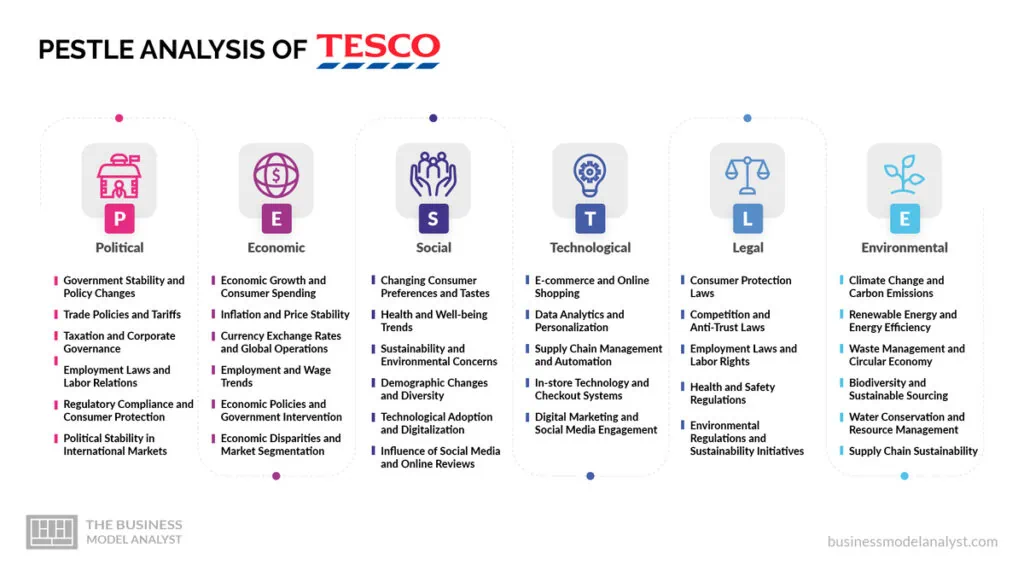Tesco, founded in 1919 by Jack Cohen, has evolved into one of the world’s largest and most successful retailers. With its headquarters in the United Kingdom, Tesco operates across multiple continents, serving millions of customers daily through its diverse range of products and services.
As a multinational retail giant, Tesco operates in a dynamic and complex business environment influenced by various external factors. Understanding the external forces that shape Tesco’s operations is crucial for the company to maintain its competitive edge and sustain its growth in the fiercely competitive retail industry.
One powerful framework for analyzing the external environment of Tesco is the PESTLE analysis. PESTLE stands for Political, Economic, Social, Technological, Legislative, and Environmental factors. It is unlike the SWOT analysis. PESTLE is a strategic tool used to identify and understand the macro-environmental factors that impact an organization’s business and decision-making processes.
Contents
Tesco Political Factors
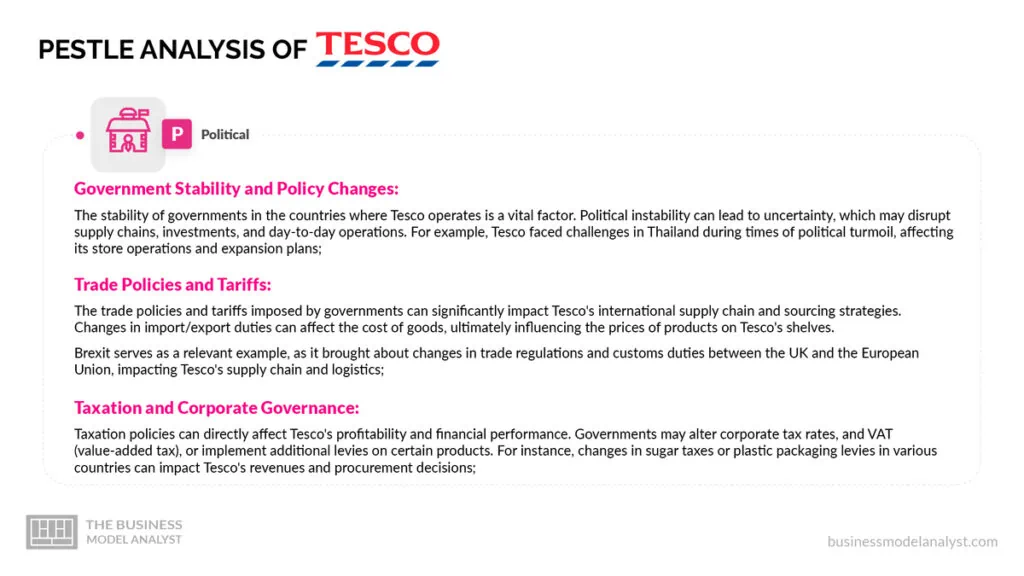
Political factors significantly shape the business environment for companies like Tesco, a leading multinational retailer. These factors encompass the influence of governments, political stability, regulations, and policies on Tesco’s operations, strategy, and profitability. Understanding and navigating the political landscape is crucial for Tesco to ensure sustainable growth and success in various markets.
- Government Stability and Policy Changes: The stability of governments in the countries where Tesco operates is a vital factor. Political instability can lead to uncertainty, which may disrupt supply chains, investments, and day-to-day operations. For example, Tesco faced challenges in Thailand during times of political turmoil, affecting its store operations and expansion plans;
- Trade Policies and Tariffs: The trade policies and tariffs imposed by governments can significantly impact Tesco’s international supply chain and sourcing strategies. Changes in import/export duties can affect the cost of goods, ultimately influencing the prices of products on Tesco’s shelves.
Brexit serves as a relevant example, as it brought about changes in trade regulations and customs duties between the UK and the European Union, impacting Tesco’s supply chain and logistics;
- Taxation and Corporate Governance: Taxation policies can directly affect Tesco’s profitability and financial performance. Governments may alter corporate tax rates, and VAT (value-added tax), or implement additional levies on certain products. For instance, changes in sugar taxes or plastic packaging levies in various countries can impact Tesco’s revenues and procurement decisions;
- Employment Laws and Labor Relations: Political decisions related to employment laws and labor relations can affect Tesco’s workforce management and labor costs. Minimum wage laws, overtime regulations, and trade union actions can influence labor dynamics. For example, changes in the minimum wage in the UK have had implications on Tesco’s operating costs and hiring practices;
- Regulatory Compliance and Consumer Protection: Governments enact laws and regulations to protect consumers’ interests and maintain fair competition. Tesco must comply with various regulatory requirements, such as food safety standards, labeling regulations, and advertising laws. Non-compliance can lead to legal issues, reputational damage, and financial penalties;
- Political Stability in International Markets: Tesco’s global expansion exposes it to different political environments across various countries. Political stability or instability in these markets can significantly impact Tesco’s operations and expansion plans. For instance, sociopolitical unrest in Turkey or Brazil may pose challenges for Tesco’s growth strategies in these regions;
- Government Incentives and Subsidies: Governments often provide incentives and subsidies to encourage certain industries or promote specific behaviors. Tesco may benefit from government support for sustainable initiatives, renewable energy usage, or community development programs. For example, Tesco’s efforts to reduce carbon emissions align with government initiatives on environmental sustainability;
- Competition Policy and Anti-Trust Regulation: Political decisions related to competition policy and antitrust regulation can influence Tesco’s market position. Governments may restrict mergers and acquisitions to prevent monopolies or enforce fair competition practices. Tesco’s acquisition attempts or expansion strategies may face regulatory scrutiny in various markets.
Example: Tesco in India
In 2008, Tesco initiated plans to enter the Indian retail market. However, the company faced political obstacles in the form of strict Foreign Direct Investment (FDI) regulations. The Indian government required multi-brand retailers to source 30% of their products from local small and medium-sized enterprises.
This condition posed a challenge for Tesco in setting up its supply chain and meeting the local sourcing requirements. It took several years of lobbying and negotiations for Tesco to finally establish a joint venture with Tata Group in 2013, allowing them to enter the Indian retail market.
Tesco Economic Factors
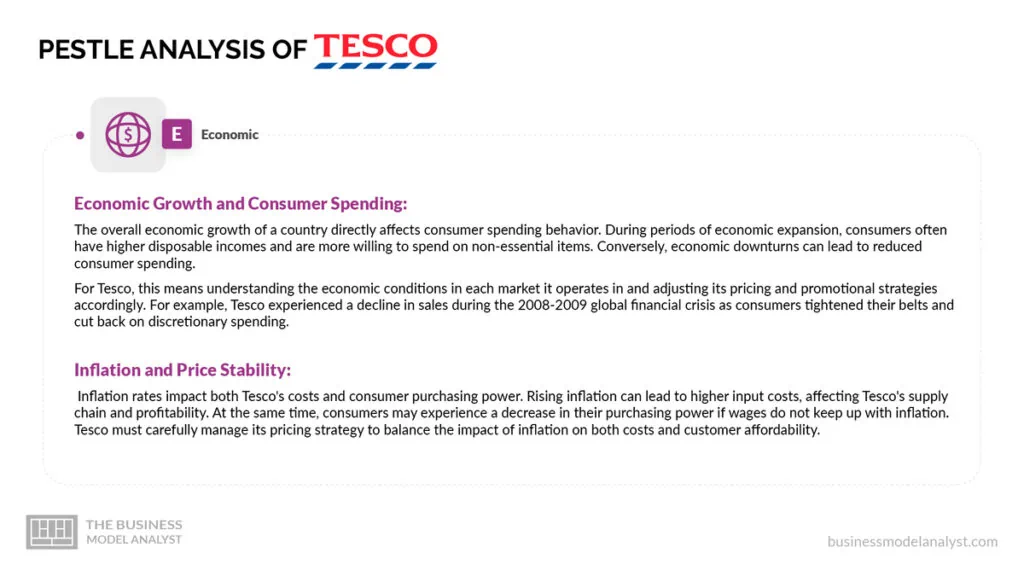
Economic factors significantly influence the performance and strategic decisions of Tesco, as they do with any multinational retailer. As one of the world’s largest retail chains, Tesco’s operations are intricately tied to global economic conditions, including growth rates, inflation, exchange rates, and consumer spending patterns.
- Economic Growth and Consumer Spending: The overall economic growth of a country directly affects consumer spending behavior. During periods of economic expansion, consumers often have higher disposable incomes and are more willing to spend on non-essential items. Conversely, economic downturns can lead to reduced consumer spending.
For Tesco, this means understanding the economic conditions in each market it operates in and adjusting its pricing and promotional strategies accordingly. For example, Tesco experienced a decline in sales during the 2008-2009 global financial crisis as consumers tightened their belts and cut back on discretionary spending.
- Inflation and Price Stability: Inflation rates impact both Tesco’s costs and consumer purchasing power. Rising inflation can lead to higher input costs, affecting Tesco’s supply chain and profitability. At the same time, consumers may experience a decrease in their purchasing power if wages do not keep up with inflation. Tesco must carefully manage its pricing strategy to balance the impact of inflation on both costs and customer affordability.
Example: Tesco in Argentina
When Tesco entered the Argentine market, it faced a significant challenge due to the country’s high inflation rates. The fluctuating inflation made it difficult for Tesco to set stable prices, and the company had to adopt flexible pricing strategies to adjust to the changing economic conditions.
Moreover, managing supply chain costs and maintaining profitability in the face of rapid inflation required Tesco to adopt robust financial planning and risk management practices.
- Currency Exchange Rates and Global Operations: Tesco’s international presence exposes it to currency exchange rate fluctuations. When the value of the local currency declines against the pound sterling (Tesco’s home currency), Tesco’s international profits may be negatively affected.
Currency risk management becomes crucial for Tesco to mitigate the impact of exchange rate movements on its financial performance. Brexit serves as a relevant example, as it led to uncertainty in currency markets and affected Tesco’s operations, supply chain, and currency hedging strategies.
- Employment and Wage Trends: Labor costs are a significant component of Tesco’s operational expenses. Economic factors, such as changes in minimum wage laws or unemployment rates, can impact labor costs and workforce management. For instance, an increase in the minimum wage in the UK could lead to higher labor expenses for Tesco, potentially impacting its profit margins.
- Economic Policies and Government Intervention: Government economic policies, such as monetary and fiscal measures, can have a profound impact on Tesco’s operations. Interest rate changes, for example, can affect borrowing costs for Tesco’s expansion plans or capital investments. Additionally, stimulus packages or tax incentives may influence consumer spending behavior and overall market dynamics.
- Economic Disparities and Market Segmentation: Economic disparities between regions or socioeconomic groups can influence Tesco’s market segmentation and product offerings. In economically disadvantaged areas, Tesco may face challenges in achieving profitability, leading to store closures or restructuring strategies. On the other hand, the company may need to tailor its product assortment and pricing in affluent areas to meet the demands of higher-income consumers.
Example: Tesco in China
When Tesco entered the Chinese market, it encountered challenges related to economic disparities between urban and rural regions. The company had to adapt its store formats and product offerings to cater to the diverse needs of consumers across different income levels.
Tesco strategically positioned its stores and launched localized marketing campaigns to appeal to both urban consumers seeking premium products and rural consumers looking for value-oriented options.
Tesco Social Factors
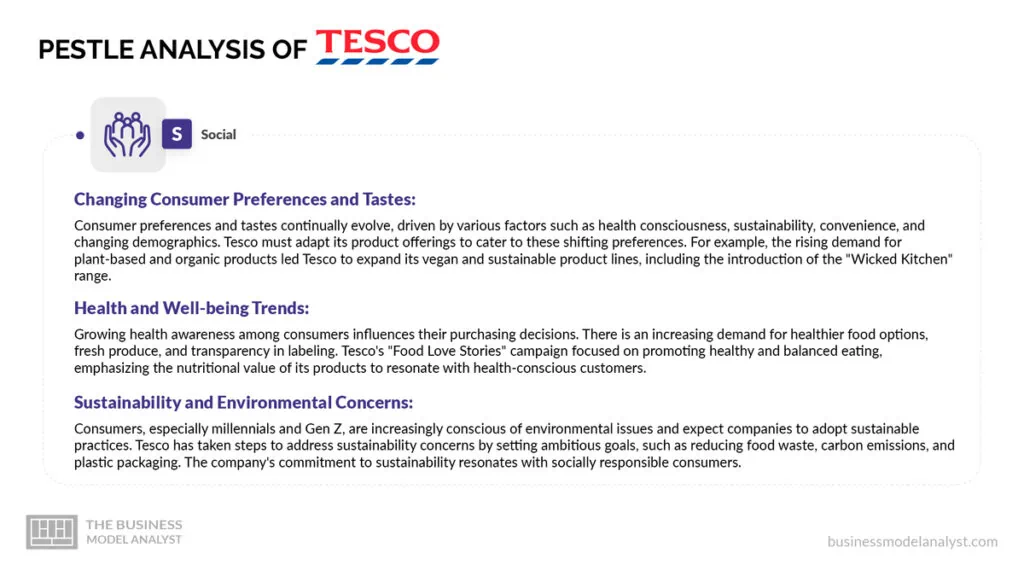
Social factors are integral to Tesco’s business as they encompass the diverse attitudes, beliefs, lifestyles, and cultural influences of the communities in which Tesco operates. Understanding and responding to these social dynamics is crucial for Tesco to build strong customer relationships, enhance brand perception, and align its products and services with the evolving needs of consumers.
- Changing Consumer Preferences and Tastes: Consumer preferences and tastes continually evolve, driven by various factors such as health consciousness, sustainability, convenience, and changing demographics. Tesco must adapt its product offerings to cater to these shifting preferences. For example, the rising demand for plant-based and organic products led Tesco to expand its vegan and sustainable product lines, including the introduction of the “Wicked Kitchen” range.
- Health and Well-being Trends: Growing health awareness among consumers influences their purchasing decisions. There is an increasing demand for healthier food options, fresh produce, and transparency in labeling. Tesco’s “Food Love Stories” campaign focused on promoting healthy and balanced eating, emphasizing the nutritional value of its products to resonate with health-conscious customers.
- Sustainability and Environmental Concerns: Consumers, especially millennials and Gen Z, are increasingly conscious of environmental issues and expect companies to adopt sustainable practices. Tesco has taken steps to address sustainability concerns by setting ambitious goals, such as reducing food waste, carbon emissions, and plastic packaging. The company’s commitment to sustainability resonates with socially responsible consumers.
Example: Tesco’s Plastic Reduction Initiatives
In response to growing environmental concerns, Tesco pledged to reduce its reliance on single-use plastics. The company set a target to remove one billion pieces of plastic from its UK stores by the end of 2020. This initiative, encompassing changes in packaging design and offering more sustainable alternatives, demonstrates Tesco’s responsiveness to social demands for environmental sustainability.
- Demographic Changes and Diversity: Demographic shifts, such as aging populations and increasing cultural diversity, influence Tesco’s marketing and product strategies. For instance, Tesco recognizes the importance of catering to the needs of older customers and has implemented measures to enhance accessibility and convenience for senior shoppers.
- Technological Adoption and Digitalization: The widespread use of technology and digital platforms has transformed consumer behavior and shopping habits. Tesco has embraced digitalization by investing in online shopping platforms, mobile applications, and loyalty programs. The Tesco Clubcard, a successful loyalty program, leverages customer data to personalize offers and promotions based on individual shopping habits and preferences.
- Influence of Social Media and Online Reviews: Social media platforms and online reviews significantly influence consumers’ perceptions and purchasing decisions. Tesco actively engages with customers on social media, responding to queries and feedback to maintain positive brand sentiment and address any concerns promptly.
Example: Tesco’s Customer Engagement on Twitter
Tesco’s Twitter account actively interacts with customers, providing responsive and personalized customer service. The company’s approach to handling customer inquiries and feedback in a timely and empathetic manner enhances its reputation and fosters customer loyalty.
- Cultural Sensitivity and Localization: Tesco’s global presence requires it to be culturally sensitive and adapt its offerings to local preferences and customs. Tailoring product assortments, marketing messages, and store layouts to specific cultural contexts allows Tesco to build stronger connections with customers worldwide.
Example: Tesco’s Operations in Thailand
Tesco’s operations in Thailand exemplify the company’s cultural sensitivity. The stores in Thailand offer a wide range of Thai products and localize their product mix to suit regional tastes, reflecting the importance of understanding and embracing local cultural nuances.
- Community Engagement and Corporate Social Responsibility (CSR): Tesco’s reputation is closely tied to its engagement with local communities and social responsibility initiatives. The company invests in community projects, charitable endeavors, and educational programs, fostering positive relationships with the neighborhoods it serves.
Example: Tesco Community Food Connection
Through its Community Food Connection program, Tesco redistributes surplus food to local charities and community groups, contributing to food security and reducing food waste. This initiative demonstrates Tesco’s commitment to social welfare and responsible business practices.
Tesco Technological Factors

Technological factors have become a critical aspect of Tesco’s business operations and growth strategy. As the retail industry evolves rapidly with advancements in technology, Tesco must continually embrace innovation to enhance customer experiences, optimize supply chain management, and stay ahead of competitors.
In this extensive analysis, we will delve deep into the technological factors impacting Tesco and provide practical examples to illustrate their influence.
- E-commerce and Online Shopping: The proliferation of e-commerce and online shopping has transformed the retail landscape. Tesco has recognized the significance of this shift and invested heavily in its online platforms. Tesco’s website and mobile applications enable customers to shop conveniently from the comfort of their homes, offering a wide range of products and delivery options. The company’s online presence has played a crucial role in maintaining customer loyalty and expanding its market reach.
Example: Tesco’s Online Growth during COVID-19
The COVID-19 pandemic accelerated the adoption of online shopping. During the pandemic, Tesco experienced a surge in online orders as consumers sought contactless shopping options. Tesco’s robust e-commerce infrastructure allowed it to adapt quickly and meet the increased demand for online grocery deliveries.
- Data Analytics and Personalization: Tesco leverages data analytics and customer insights to personalize the shopping experience. Through its Clubcard loyalty program and online platforms, Tesco collects valuable data on customer preferences and shopping habits. Analyzing this data helps Tesco tailor promotions, offers, and product recommendations, thereby enhancing customer satisfaction and loyalty.
- Supply Chain Management and Automation: Technological advancements have enabled Tesco to optimize its supply chain management through automation and advanced logistics systems. These innovations streamline inventory management, reduce lead times, and enhance the efficiency of distribution centers and warehouses.
Example: Tesco’s Use of Robotics in Warehouses
Tesco has deployed robotics and automation in its warehouses to accelerate order picking and packing processes. Automated systems help ensure faster and more accurate order fulfillment, enabling Tesco to meet customer expectations for prompt deliveries.
- In-store Technology and Checkout Systems: Tesco continuously updates its in-store technology to improve the shopping experience. Self-checkout kiosks, contactless payment options, and digital signage are some of the innovations that Tesco has integrated into its stores. These technologies enhance convenience for customers and reduce waiting times at the checkout counters.
- Digital Marketing and Social Media Engagement: Tesco utilizes digital marketing channels and social media platforms to engage with customers and promote its products and services. Through targeted advertising and interactive campaigns, Tesco reaches its target audience effectively and drives online and offline sales.
Example: Tesco’s Social Media Campaigns
Tesco’s social media presence, including Facebook, Twitter, and Instagram, is actively used to engage with customers and address their inquiries and concerns promptly. Additionally, Tesco runs creative social media campaigns that align with seasonal events and trends to capture consumer attention and boost brand awareness.
Tesco Legislative Factors
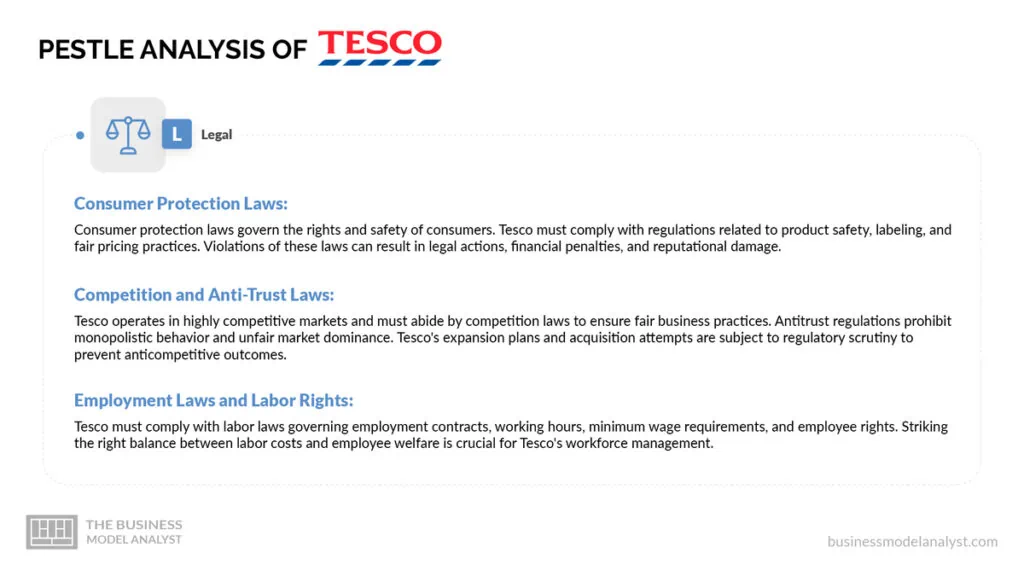
Legislative/legal factors encompass the legal and regulatory environment in which Tesco operates. These factors are critical as they shape the company’s compliance requirements, business practices, and interactions with various stakeholders. Understanding and adhering to legislative frameworks are essential for Tesco to maintain its reputation, ensure ethical conduct, and avoid legal repercussions.
- Consumer Protection Laws: Consumer protection laws govern the rights and safety of consumers. Tesco must comply with regulations related to product safety, labeling, and fair pricing practices. Violations of these laws can result in legal actions, financial penalties, and reputational damage.
- Competition and Anti-Trust Laws: Tesco operates in highly competitive markets and must abide by competition laws to ensure fair business practices. Antitrust regulations prohibit monopolistic behavior and unfair market dominance. Tesco’s expansion plans and acquisition attempts are subject to regulatory scrutiny to prevent anticompetitive outcomes.
Practical Example: Tesco’s Acquisition of Booker Group
In 2017, Tesco sought to acquire Booker Group, a major food wholesaler in the UK. The proposed merger faced a detailed investigation by the Competition and Markets Authority (CMA) to assess potential impacts on competition in the food retail and wholesale sectors. After a thorough review, the CMA approved the merger subject to certain conditions to address competition concerns.
- Employment Laws and Labor Rights: Tesco must comply with labor laws governing employment contracts, working hours, minimum wage requirements, and employee rights. Striking the right balance between labor costs and employee welfare is crucial for Tesco’s workforce management.
Example: Tesco and Minimum Wage Compliance
In the UK, Tesco faced criticism in the past for underpaying some of its staff due to payroll errors. The company took steps to rectify the issue and ensure compliance with minimum wage regulations. Being in line with employment laws is essential to uphold Tesco’s reputation as a responsible employer.
- Health and Safety Regulations: Tesco operates numerous stores and distribution centers, and compliance with health and safety regulations is of paramount importance. Ensuring the well-being of customers, employees, and suppliers is essential to avoid legal liabilities and maintain a positive brand image.
Example: Tesco’s COVID-19 Safety Measures
During the COVID-19 pandemic, Tesco implemented stringent health and safety measures to protect customers and employees. These measures included social distancing guidelines, mandatory face coverings, enhanced sanitation protocols, and contactless payments. Compliance with such regulations reassured customers and employees about their safety while shopping at Tesco stores.
- Environmental Regulations and Sustainability Initiatives: Tesco faces increasing scrutiny regarding its environmental impact and sustainability efforts. Governments worldwide are implementing regulations to address climate change and reduce carbon emissions. Tesco’s commitment to sustainability aligns with these legislative objectives.
Example: Tesco’s Plastic Reduction Commitment
In response to environmental concerns, Tesco pledged to reduce single-use plastics across its operations. The company has actively worked to eliminate plastic packaging and promote reusable alternatives, demonstrating its dedication to meeting sustainability targets.
- Data Protection and Privacy Laws: With the increasing use of customer data for personalized marketing and business insights, Tesco must adhere to data protection and privacy laws to safeguard customer information. Violating data privacy regulations can lead to severe consequences, including fines and reputational damage.
Tesco Environmental Factors
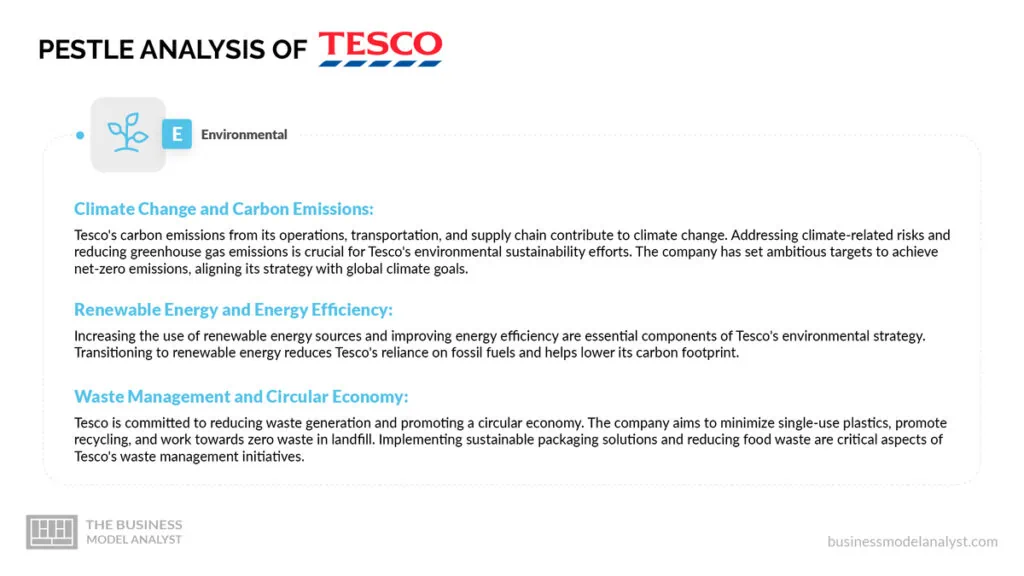
Environmental factors have become increasingly significant for Tesco, as sustainability and environmental responsibility have become critical concerns for businesses and consumers alike. As one of the largest retailers globally, Tesco faces growing pressure to address its environmental impact and implement eco-friendly practices.
- Climate Change and Carbon Emissions: Tesco’s carbon emissions from its operations, transportation, and supply chain contribute to climate change. Addressing climate-related risks and reducing greenhouse gas emissions is crucial for Tesco’s environmental sustainability efforts. The company has set ambitious targets to achieve net-zero emissions, aligning its strategy with global climate goals.
Example: Tesco’s “Science-Based Targets”
Tesco has committed to reducing its carbon emissions in line with the Science-Based Targets initiative [1], which aims to limit global warming to 1.5 degrees Celsius above pre-industrial levels. By setting science-based targets, Tesco demonstrates its dedication to combating climate change.
- Renewable Energy and Energy Efficiency: Increasing the use of renewable energy sources and improving energy efficiency are essential components of Tesco’s environmental strategy. Transitioning to renewable energy reduces Tesco’s reliance on fossil fuels and helps lower its carbon footprint.
Example: Tesco’s Solar Installations
Tesco has invested in solar panel installations on the rooftops of its stores and distribution centers. These solar power systems generate clean energy, reducing the company’s reliance on conventional electricity and contributing to its renewable energy goals.
- Waste Management and Circular Economy: Tesco is committed to reducing waste generation and promoting a circular economy. The company aims to minimize single-use plastics, promote recycling, and work towards zero waste in landfill. Implementing sustainable packaging solutions and reducing food waste are critical aspects of Tesco’s waste management initiatives.
- Biodiversity and Sustainable Sourcing: Tesco recognizes the importance of protecting biodiversity and ensuring sustainable sourcing of raw materials. The company works with suppliers to promote sustainable agricultural practices, such as responsible sourcing of palm oil and cocoa.
Example: Tesco’s Sustainable Seafood Sourcing
Tesco is committed to responsibly sourcing seafood products to protect marine biodiversity. The company collaborates with fisheries and aquaculture partners to ensure that seafood is sourced from sustainable and well-managed fisheries, as certified by organizations like the Marine Stewardship Council (MSC) or the Aquaculture Stewardship Council (ASC).
- Water Conservation and Resource Management: Water is a critical natural resource, and Tesco focuses on water conservation efforts throughout its operations. Implementing water-efficient technologies, such as rainwater harvesting and water recycling, helps Tesco minimize its water footprint.
Example: Tesco’s Water Stewardship Initiatives
Tesco has engaged in water stewardship initiatives to promote responsible water management. In areas facing water scarcity, Tesco collaborates with local communities and authorities to conserve water resources and ensure sustainable usage.
- Supply Chain Sustainability: Tesco’s supply chain plays a crucial role in its environmental impact. The company collaborates with suppliers to ensure ethical and sustainable practices throughout the supply chain, including responsible sourcing, reduced emissions, and efficient logistics.
Example: Tesco’s Sustainable Agriculture Programs
Tesco works with farmers and suppliers to promote sustainable agriculture practices. Initiatives such as the “Tesco Sustainable Dairy Group” help dairy farmers implement environmentally friendly farming practices while maintaining fair prices for their products.
Conclusion
As Tesco continues to grow and expand its global presence, monitoring and understanding these external factors remain critical. By proactively addressing political, economic, social, technological, legislative, and environmental changes, Tesco can position itself as a sustainable and responsible retail leader.


